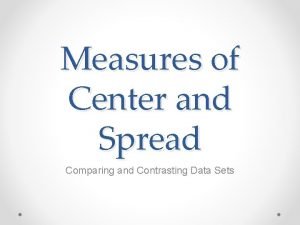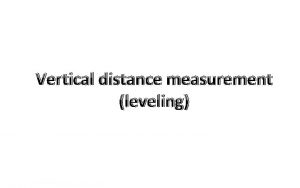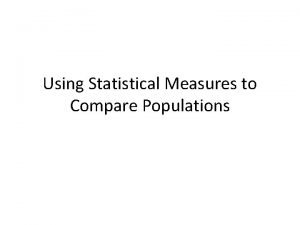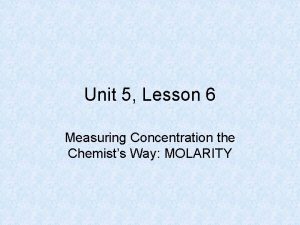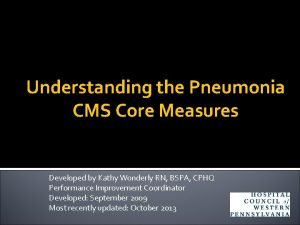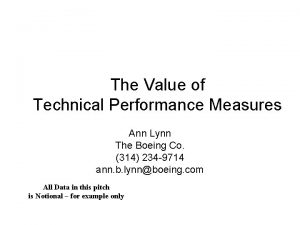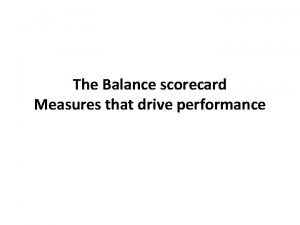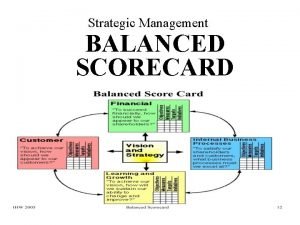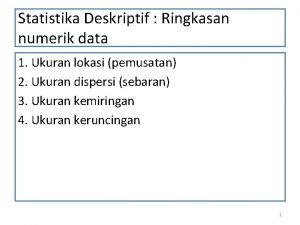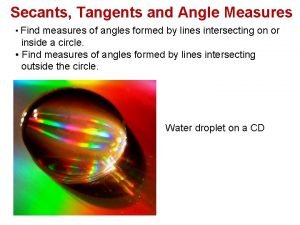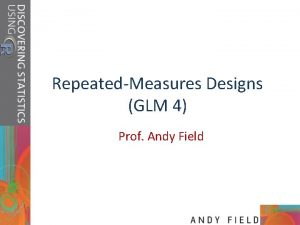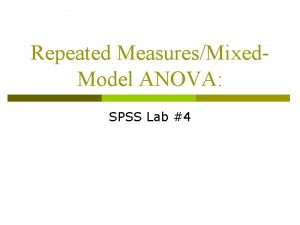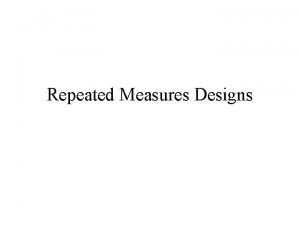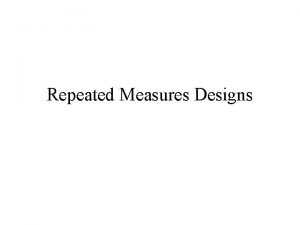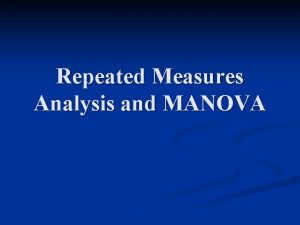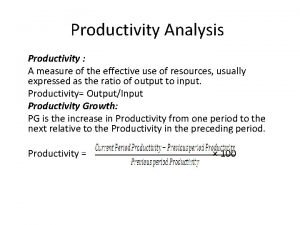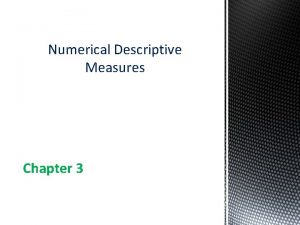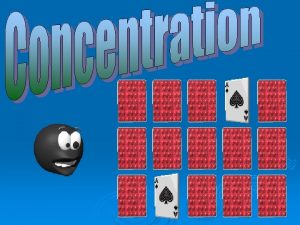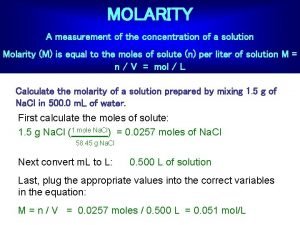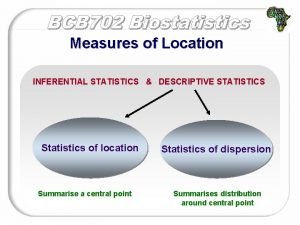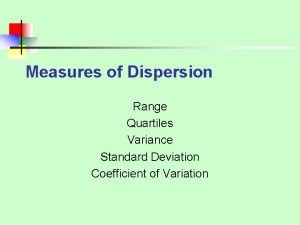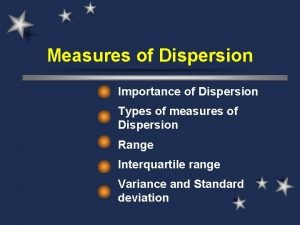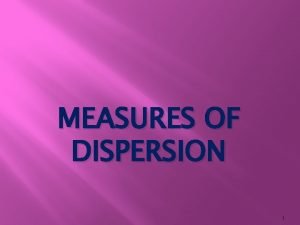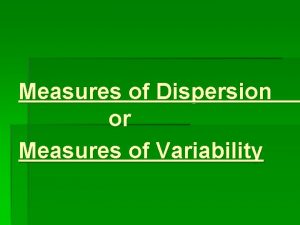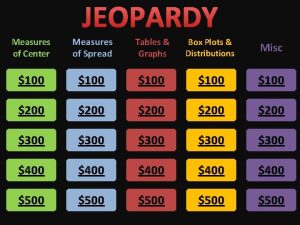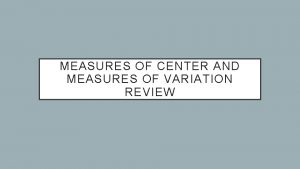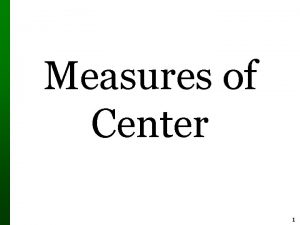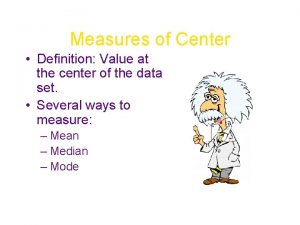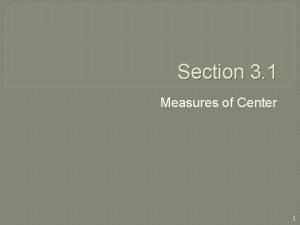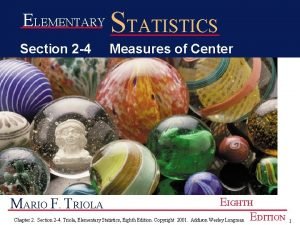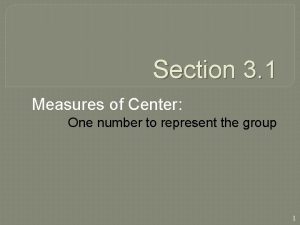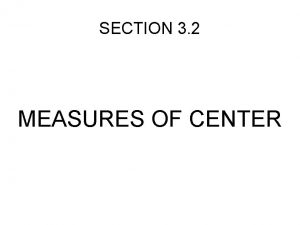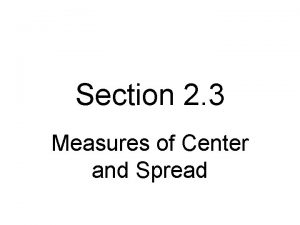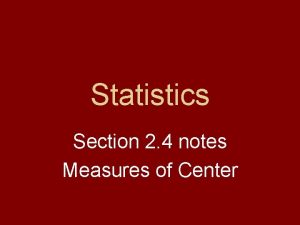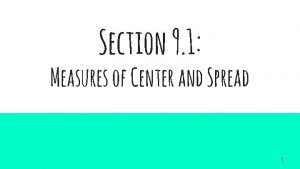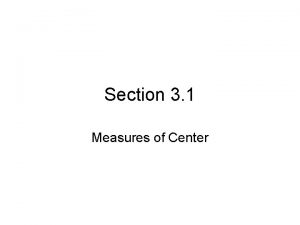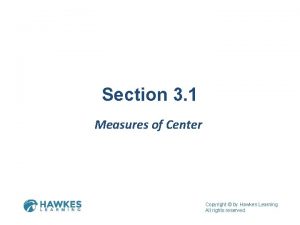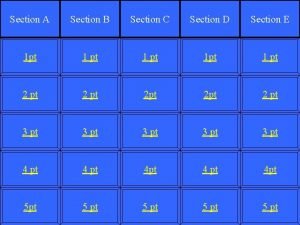Section 3 2 Measures of Center 3 1



















































- Slides: 51

Section 3 -2 Measures of Center 3. 1 - 1

Measure of Center It is the value at the center or middle of a data set. 3. 1 - 2

Arithmetic Mean (Mean) It is the measure of center obtained by adding the values and dividing the total by the number of values. What most people call an average. 3. 1 - 3

Notation denotes the sum of a set of values. is the variable usually used to represent the individual data values. represents the number of data values in a sample. represents the number of data values in a population. 3. 1 - 4

Notation The symbol for mean is pronounced ‘x-bar’ and denotes the mean of a set of sample values The mean is calculated as follows. 3. 1 - 5

Mean Advantages It is relatively reliable, means of samples drawn from the same population don’t vary as much as other measures of center Takes every data value into account Disadvantage It is sensitive to every data value, one extreme value can affect it dramatically; is not a resistant measure of center 3. 1 - 6

Median It is the middle value when the original data values are arranged in order of increasing (or decreasing) magnitude. 3. 1 - 7

Finding the Median First sort the values (arrange them in order), the follow one of these 1. If the number of data values is odd, the median is the number located in the exact middle of the list. 2. If the number of data values is even, the median is found by computing the mean of the two middle numbers. 3. 1 - 8

5. 40 1. 10 0. 42 0. 73 0. 48 1. 10 0. 42 0. 48 0. 73 1. 10 5. 40 (in order - even number of values – no exact middle shared by two numbers) 0. 73 + 1. 10 MEDIAN is 0. 915 2 5. 40 1. 10 0. 42 0. 73 0. 48 1. 10 0. 66 0. 42 0. 48 0. 66 0. 73 1. 10 5. 40 (in order - odd number of values) exact middle MEDIAN is 0. 73 3. 1 - 9

Mode is the value that occurs with the greatest frequency. It is the only measure of central tendency that can be used with nominal data. Data set can have one, more than one, or no mode Bimodal two data values occur with the same greatest frequency Multimodal more than two data values occur with the same greatest frequency No Mode no data value is repeated 3. 1 - 10

Mode - Examples a. 5. 40 1. 10 0. 42 0. 73 0. 48 1. 10 Mode is 1. 10 b. 27 27 27 55 55 55 88 88 99 Bimodal - 27 & 55 c. 1 2 3 6 7 8 9 10 No Mode 3. 1 - 11

Definition Midrange It is the value midway between the maximum and minimum values in the original data set 3. 1 - 12

Midrange Sensitive to extremes It uses only the maximum and minimum values, and it is rarely used. Redeeming Features (1) It is very easy to compute (2) It reinforces that there are several ways to define the center (3) You must avoid confusion with median 3. 1 - 13

Round-off Rule for Measures of Center Carry one more decimal place than is present in the original set of values. 3. 1 - 14

Best Measure of Center 3. 1 - 15

Skewed and Symmetric The distribution of data is symmetric if the left half of its histogram is roughly a mirror image of its right half Skewed The distribution of data is skewed if it is not symmetric and extends more to one side than the other 3. 1 - 16

Skewed Left or Right Skewed to the left A distribution (also called negatively skewed) have a longer left tail, mean and median are to the left of the mode Skewed to the right A distribution (also called positively skewed) have a longer right tail, mean and median are to the right of the mode 3. 1 - 17

Skewness 3. 1 - 18

Section 3 -3 Measures of Variation 3. 1 - 19

Definition The range of a set of data values is the difference between the maximum data value and the minimum data value. Range = (maximum value) – (minimum value) It is very sensitive to extreme values; therefore not as useful as other measures of variation. 3. 1 - 20

Variance 3. 1 - 21

Sample Standard Deviation The standard deviation of a set of sample values, denoted by s, is the square root s of the following formula (sample variance s 2): 3. 1 - 22

Properties of the Standard Deviation (1) The standard deviation is a measure of variation of all values from the mean. The value of the standard deviation s is nonnegative. The value of the standard deviation s can increase dramatically with the inclusion of one or more extreme values (data values far away from all others). 3. 1 - 23

Properties of the Standard Deviation (2) • Measures the variation among data values • Values close together have a small standard deviation, but values with much more variation have a larger standard deviation • Has the same units of measurement as the original data 3. 1 - 24

Empirical (or 68 -95 -99. 7) Rule For data sets having a distribution that is approximately bell shaped, the following properties apply: About 68% of all values fall within 1 standard deviation of the mean. About 95% of all values fall within 2 standard deviations of the mean. About 99. 7% of all values fall within 3 standard deviations of the mean. 3. 1 - 25

The Empirical Rule 3. 1 - 26

The Empirical Rule 3. 1 - 27

The Empirical Rule 3. 1 - 28

Range Rule of Thumb It is based on the principle that for many data sets, the vast majority (such as 95%) of sample values lie within two standard deviations of the mean. 3. 1 - 29

Range Rule of Thumb for Interpreting a Known Value of the Standard Deviation Informally define usual values in a data set to be those that are typical and not too extreme. Find rough estimates of the minimum and maximum “usual” sample values as follows: 3. 1 - 30

Properties of the Standard Deviation (3) • For many data sets, a value is unusual if it differs from the mean by more than two standard deviations • Compare standard deviations of two different data sets only if they use the same scale and units, and they have means that are approximately the same 3. 1 - 31

Coefficient of Variation 3. 1 - 32

Section 3 -4 Measures of Relative Standing and Boxplots 3. 1 - 33

Z score (or standardized value) the number of standard deviations that a given value X is above or below the mean X - Mean Standard Deviation 3. 1 - 34

Interpreting Z Scores Whenever a value is less than the mean, its corresponding z score is negative Ordinary values are between -2 and 2 Unusual Values are outside the above range 3. 1 - 35

Percentiles They are measures of location. There are 99 percentiles denoted P 1, P 2, . . . P 99, which divide a set of data into 100 groups with about 1% of the values in each group. 3. 1 - 36

Finding the Percentile of a Data Value 3. 1 - 37

Quartiles Are measures of location, denoted Q 1, Q 2, and Q 3, which divide a set of data into four groups with about 25% of the values in each group. Q 1 (First Quartile) separates the bottom 25% of sorted values from the top 75%. Q 2 (Second Quartile) same as the median; separates the bottom 50% of sorted values from the top 50%. Q 3 (Third Quartile) separates the bottom 75% of sorted values from the top 25%. 3. 1 - 38

Quartiles Q 1, Q 2, Q 3 divide ranked scores into four equal parts 3. 1 - 39

5 -Number Summary For a set of data, the 5 -number summary consists of the minimum value; the first quartile Q 1; the median (or second quartile Q 2); the third quartile, Q 3; and the maximum value. 3. 1 - 40

Interquartile Range It is used for the measure of variation, and defined as the difference between Q 1 and Q 3: IQR = Q 3 - Q 1 3. 1 - 41

Boxplot A boxplot (or box-and-whiskerdiagram) is a graph of a data set that consists of a line extending from the minimum value to the maximum value, and a box with lines drawn at the first quartile, Q 1; the median; and the third quartile, Q 3. 3. 1 - 42

Boxplots Boxplot of Movie Budget Amounts 3. 1 - 43

Boxplots - Normal Distribution: Heights from a Simple Random Sample of Women 3. 1 - 44

Boxplots - Skewed Distribution: Salaries (in thousands of dollars) of NCAA Football Coaches 3. 1 - 45

Outliers An outlier is a value that lies very far away from the vast majority of the other values in a data set. 3. 1 - 46

Important Principles An outlier can have a dramatic effect on the mean. An outlier can have a dramatic effect on the standard deviation. An outlier can have a dramatic effect on the scale of the histogram so that the true nature of the distribution is totally obscured. 3. 1 - 47

Outliers for Modified Boxplots For purposes of constructing modified boxplots, we can consider outliers to be data values meeting specific criteria. In modified boxplots, a data value is an outlier if it is. . . or above Q 3 by an amount greater than 1. 5 IQR below Q 1 by an amount greater than 1. 5 IQR 3. 1 - 48

Modified Boxplots described earlier are called skeletal (or regular) boxplots. Some statistical packages provide modified boxplots which represent outliers as special points. 3. 1 - 49

Modified Boxplot Construction A modified boxplot is constructed with these specifications: A special symbol (such as an asterisk) is used to identify outliers. The solid horizontal line extends only as far as the minimum data value that is not an outlier and the maximum data value that is not an outlier. 3. 1 - 50

Modified Boxplots - Example Pulse rates of females listed in Data Set 1 in Appendix B. 3. 1 - 51
 Anova repeated measures
Anova repeated measures Measures of center and spread worksheet
Measures of center and spread worksheet Nationalism at center stage
Nationalism at center stage Chapter 7 section 2 nationalism at center stage
Chapter 7 section 2 nationalism at center stage Gibbons v ogden nationalism
Gibbons v ogden nationalism Enumerate the types of revolve section view
Enumerate the types of revolve section view Define a revolved section view?
Define a revolved section view? Section lining symbols
Section lining symbols Work and energy section 2 describing energy
Work and energy section 2 describing energy Study guide chapter 10 section 1 meiosis
Study guide chapter 10 section 1 meiosis Measure of the vertical distance
Measure of the vertical distance Using statistical measures to compare populations
Using statistical measures to compare populations Measures of concentration molarity quiz
Measures of concentration molarity quiz Causes of unemployment
Causes of unemployment Core measures for pneumonia
Core measures for pneumonia Rumus skewness dan kurtosis data kelompok
Rumus skewness dan kurtosis data kelompok Rumus odds ratio
Rumus odds ratio Weights and measures training
Weights and measures training Technical performance measures
Technical performance measures The balanced scorecard measures that drive performance
The balanced scorecard measures that drive performance Technical performance measure
Technical performance measure Target hardening measures
Target hardening measures Strategic measures
Strategic measures Numerical description
Numerical description Practice 11-4 angle measures and segment lengths
Practice 11-4 angle measures and segment lengths Find xx
Find xx Secants tangents and angles
Secants tangents and angles Andy field anova
Andy field anova Multivariate anova spss
Multivariate anova spss Repeated-measures design
Repeated-measures design Anova repeated measures
Anova repeated measures Repeated measures manova spss
Repeated measures manova spss Raleigh & rosse measures to motivate exceptional service
Raleigh & rosse measures to motivate exceptional service Ami core measures
Ami core measures Matched pairs design advantages and disadvantages
Matched pairs design advantages and disadvantages Between measures design
Between measures design A partial operational productivity measure:
A partial operational productivity measure: Pinch point signage
Pinch point signage Skala stapel
Skala stapel Types of anemia ppt
Types of anemia ppt Asthma internist kenai peninsula
Asthma internist kenai peninsula Orthographic projection of a point
Orthographic projection of a point How can employee involvement measures motivate employees
How can employee involvement measures motivate employees Numerical descriptive measures exercises
Numerical descriptive measures exercises Measures of concentration: molarity
Measures of concentration: molarity Measures of concentration: molarity
Measures of concentration: molarity Measures to correct deficient demand
Measures to correct deficient demand What is measure of location in statistics
What is measure of location in statistics Measures of variation
Measures of variation Definition of measures of dispersion
Definition of measures of dispersion Conclusion of measures of dispersion
Conclusion of measures of dispersion Define measures of dispersion
Define measures of dispersion

